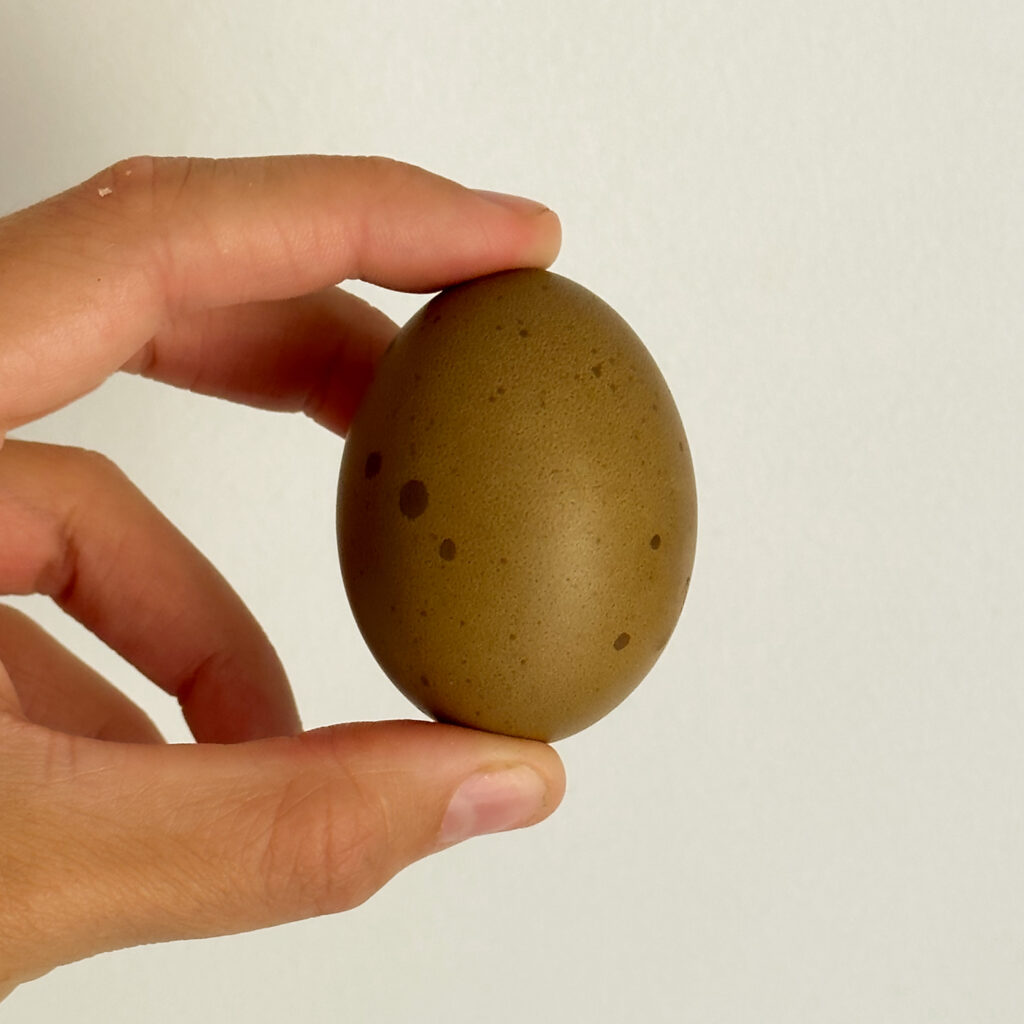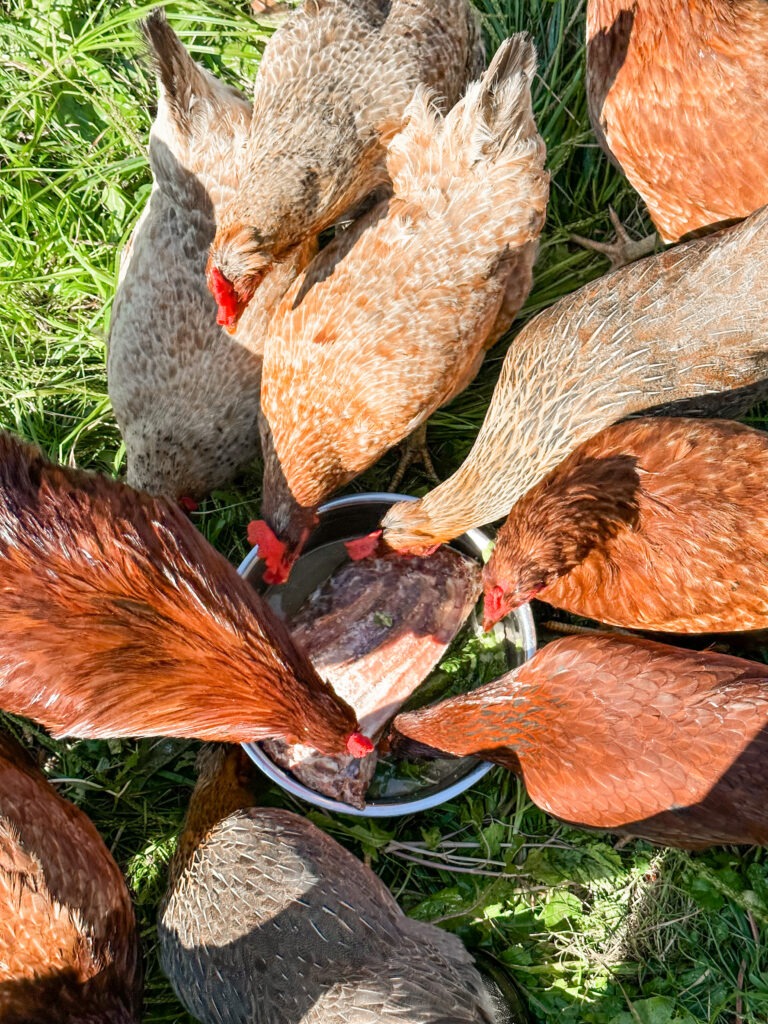How Much Does it Cost to Feed Chickens? (Plus Ways to Save)
How much does it cost to feed chickens? It might be a lot if you are only relying on store-bought feed, but there are a few ways to save! On the homestead scale, raising chickens is far more customizable to help you maximize savings on your fresh daily eggs.

Nutritional Needs for Laying Chickens
A flock of laying hens have specific nutritional needs to keep them happy, healthy, and producing eggs for your family.
Meat chickens are slightly different. For example, meat birds have higher protein needs. We do use some supplemented methods to feed our meat birds as well. If and when your family is interested in raising a year’s worth of meat chickens, I have a post about that here.
Chickens need:
- Protein
- Fat
- Carbs
- Vitamins & Minerals
One of the reasons why store-bought feed is a popular option. It’s convenient to pick up a bag of premixed feed ready made to feed to your flock. However, the convenience is paid for with money up front, which can cut into your bottom line when running a homestead and raising your own food.
How Much Does it Cost to Feed Chickens Store-Bought Feed

When calculating costs, I always start with how much it would cost to feed chickens entirely on a store-bought ration.
Typical egg laying hens require 1/4 pound of feed per chicken, per day. If you are raising a backyard flock of 12 chickens, you will need roughly 3 pounds of food for your flock every day. That adds up quickly when you figure that number out per month: roughly 90 pounds per month!
We buy 40 pound bags of Nature’s Best Organic Egg Layer Pellets from Tractor Supply for $28.99 per bag. If you figure we will need 2.25 bags of feed per month, that would total out to $65.22 per month in feed.
It doesn’t seem very economical when you plan to rely only on store-bought feed.
Thankfully, chickens are omnivores and will happily devour more than just purchased feeds.
Alternatives to Store-Bought Chicken Feed
Taking the nutrition needs of your flock into your own hands can save a considerable amount of money. However, not all alternatives will save you money on the homestead scale. Nevertheless, these are skills that are valuable to have. You might run out of food before your next planned trip to the feed store, or worse, the food your flock is used to might be out of stock!
Finding ways to diversify and take responsibility for feeding your chickens is a worthwhile endeavor.
Kitchen Food Scraps
Kitchen food scraps make up a large portion of the alternative diet our chickens are given. As a family of four eating mostly home cooked meals, we produce a substantial amount of food waste that can be allocated to our chickens. We keep a mixing bowl on the counter for any kitchen waste that can go to the chickens.
The main scraps are produced when preparing meals such as fruit and vegetable peelings/tops, bad spots on garden produce, and trimmings from meat. Every day we fill up a large mixing bowl of food scraps including egg shells which are fed back to our chickens for added calcium which is needed to produce hard egg shells when they lay.
As long as your chickens have adequate appropriate food, we do allow some scraps they don’t eat into the bowl as well. They will just leave these behind to compost into the pasture.

Food Scraps we Feed to Our Chickens
- Vegetable peelings/tops
- Fruit peelings/cores
- Leftover beef, pork and venison broth
- Leftover raw milk or whey from cheese and yogurt making
- Leftover sourdough starter
- Bread scraps
- Rice, oatmeal, beans leftover from meals
- Meal leftovers that haven’t molded, or gone bad, but isn’t getting eaten by us
Food Scraps that Shouldn’t Be Fed to Chickens
It’s important to note that many of these foods wouldn’t cause your chickens to drop dead with one bite. However, if these foods are offered as the only source of food to hungry chickens, that might be a problem
Our chickens are never starving, so even if an errant orange peel or single chocolate chip from a bite of a waffle is thrown to them, they are more likely to scratch it into the ground to compost in place than they are to eat it.
Chickens seem to know what foods are bad for them when they have better options available.
- Chocolate or candy
- Avocado peelings/pits
- Green potato skins (some say that raw potato of any kind is a no-no)
- Citrus
- Moldy food
- Dried beans (cooked are fine)
- Onions and garlic
Home Grown/Foraged Chicken Food
Another way to subsidize your chicken’s feed needs is by growing or foraging for the food they need. Chickens are omnivores and given the chance will eat meat, fruits and veggies, seeds, nuts, grass and leafy greens, as well as bugs and even mice that find their way to your flock!

One possibly surprising food our chickens get is venison from our hunting season! We butcher our deer on the homestead and the pile of waste is larger than you might think. Extra fat, damaged meat from the kill shot, and gristle is saved and ground for an added protein boost for our chickens.

We freeze quart sized bags of the less savory parts of our deer and pull these out to compliment the kitchen scraps we feed our chickens.
It’s not very often that much meat makes its way into the scrap bucket, so this is a great way to add protein to the supplemented foods.
Our kids like to get involved too. When they have busy minds and idle hands in the fall, we put their efforts into gathering seed heads from grasses around the farm. The seeds add up rather quickly and can add to the food your chickens will eat!
The garden is another source of food for our flock. We grow more food than we can eat in our garden (I’m looking at you zucchini plants), and this makes a great addition to the green component of our flock’s diet. These include the extra or blemished veggies as well as many of the plants after they are pulled out.

Some of the ones we feed are:
- Zucchini
- Tomatoes
- Cabbage
- Broccoli
- Squash
- Watermelon
- Peas
- Green beans
- Lettuce
The Plants we DON’T Feed:
- Nightshade plants (tomatoes, potatoes, eggplant)
- Onions & Garlic
- Rhubarb
Pasture Raising Chickens

This is not so much a form of supplemented feed, however, raising your flock on pasture provides extra green matter, grit, as well as protein in the form of bugs and grubs to your flock.
Moving them weekly, or even daily, provides fresh ground for them, less flies to pose a health risk, and gives them extra food.
Plus, chickens raised on pasture are healthier because they get more exercise, the scratching and pecking provides enrichment and entertainment for them, they receive a more varied diet, and are more hygienic on fresh ground regularly.
Win, win, win!
If you want to learn more about pasture raising chickens for your own meat and eggs, you can read my in-depth post on that here.
Homemade Chicken Food Blends
Some homesteaders actually spend time sourcing the individual ingredients of a premixed feed themselves. This sometimes can save money over store-bought complete feeds. However, because these blends aren’t pelleted, your chickens might pick out their favorite ingredients. This could leave behind vital nutrients and waste your hard earned money.
If you are interested in making your own feed blend, The Prairie Homestead has a recipe for that here.
How Much Does it Cost US to Feed OUR Chickens?
We do feed free choice store-bought feed to our hens daily. However, because we utilize these methods to subsidize their food needs, we spend much less on our food bill.
We have a flock of 25 laying hens and our store-bought food needs are only about 2 bags of feed per month. It totals less than $60 every month to feed 25 hens and a rooster!
To buy pastured eggs in our area would cost about $3.50/dozen, and even with our feed costs, our eggs cost us less than that!
I definitely think it is worth it to make the effort in diversifying your flock’s food needs and save some money on your eggs!

The Egg Flock

The Meat Birds
Learn about
Keeping Your Own Chickens
With their production of meat for the freezer, and fresh eggs daily, chickens make an ideal addition to any homestead or backyard. Tending to these feathered friends provides versatile source of ingredients for your favorite recipes. Keeping Chickens is a rewarding, and sustainable, way to embrace a more self-reliant lifestyle.
Pin for Later!








One other thing I have found worthy of calling out is the fantastic cost saving that can happen if a feed mill is close by! I recently switched to feed mill food and the cost dramatically went down for my 24 chickens. A 50lb bag from Rural King or TSC was the same cost as an 80lb bag from the feed mill and the food quality dramatically increased! While this may not be an option for everyone, it has dramatically cut the cost getting essentially 30lb of free food with what I was used to paying!
This is SUCH a great idea! I know that’s something that many people might not think of, but it’s one area where buying from a small, local business can really help you save!
I just LOVE this post, because if you ask this same question on literally any chicken group on facebook people will laugh at you or make you feel crazy to think you can save money or that it is financially worth it to raise your own chickens. Everyone can make it MORE expensive than it needs to be, and many can make it LESS. So this is so great to read and see the breakdown. I love seeing how feasible and cost effective this can be! Thank you!